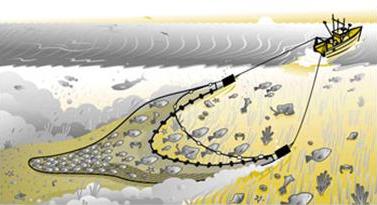Bottom Otter trawls
Bottom Otter trawls net towed by a single vessel, which the horizontal opening of is ensured by the a relatively heavy trawl otter doors that can be fitted with a steel shoe designed to withstand strong contact with the bottom
Bottom Otter trawls
Breadcrumbs
- Fisheries
- Fisheries
- Professional Fishing
- Local and Coastal Fisheries
- Fishing Gear
- Trawls
- Bottom Otter trawls
![]() Framework
Framework
![]() Description
Description
Bottom otter trawls are towed by a single vessel and its horizontal opening is ensured by the relatively heavy trawl boards, which may be fitted with a steel shoe intended to withstand strong bottom contact.
![]() Features
Features
The number of net meshes, in width, may not be increased from the front to the rear of the axis or lower in the codend. Devices which obstruct or reduce the size of the mesh or grid shall not be fitted. Linings and other devices provided for in Regulation (EC) No 3440/84 may which defines the fixation of nets in trawls, Danish seine and similar.
A maximum single and multi-thread thickness of 6 and 12 mm respectively is established.
![]() Mesh ranges
Mesh ranges
Depending on the target species:
- • Crustaceans (except lobster): 55 mm to 59 mm
- • Fish (certain species, not including hake): 65 mm to 69 mm
- • All organisms: 70 mm.
![]() Target species
Target species
Bottom otter trawl 50 to 55 mm (Crustaceans)
For vessels licensed only for 55-59 mm mesh, deep water rose shrimp, blue and red shrimp and giant red shrimp with a minimum of 30% target species.
If vessels are also licensed for mesh sizes of 70 mm or over, the percentage of target species shall be reduced to 20%.
Fish and cephalopods other than blue whiting may not be caught in quantities exceeding 30%.
Bottom otter trawl 65 to 69 mm and ≥ 70 mm (Fish)
Main target species with 70% target species: horse mackerel, blue whiting, squid, octopus, sea breams, catsharks, neon flying squid, pouting, wedge sole, conger, blackbelly rosefish, rockfish, Atlantic pomfret, alfonsinos, thickback sole, piper gurnard, and large-scaled gurnard.
If fishing is directed to other species such as hake, monkfish, megrim or whiting, these being over 30% of the catches, the legal mesh size is ≥ 70 mm.
Crustaceans may not be caught in quantities exceeding 30%.
In both cases, sardines may not be kept on board in quantities exceeding 10% of the total.
![]() Area of action
Area of action
Between the 6 miles from the shoreline or the tie line of Capes Sines, Espichel and Raso (where applicable) and 200 miles. Vessels under 36 GT registered in Cascais may operate within 6 miles from the baselines, provided that they are more than 6 miles from the shoreline.
![]() Other constraints
Other constraints
No fishing in an area of the Costa Vicentina between 37º 50´N and 37º 00´ from December and February.
Fishing for Norway lobster in an area off the Sines (between 38º 10´N and 37º 45´N) is prohibited, except as by-catch up to 2% of the total on board between 1 May and 31 August and up to 5% in the remaining months.
Between 1 and 31 January, the fishing by crustacean trawlers (55-59 mm mesh size) is prohibited and the vessels licensed for this gear, even if licensed for ≥ 70 mm mesh size, must remain in port.
![]() Images
Images

![]() Legislation
Legislation
| National Legislation | |
| Ordinance No 349/2013 of 29 November, republishes the Ordinance No 1102-E/ 2000 of 22 November | Ordinance No 349/2013 |
| Ordinance No 43/2006 of 12 January, establishing management measures for fishing for crustaceans | Ordinance No 43/2006 |
| Ordinance No 1102-E/2000 of 22 November, approving the Trawl Fishing Regulation | Ordinance No 1102-E/2000 |
| EU Legislation | |
| Commission Regulation (EU) No 404/2011 of 8 April 2011, which includes rules for trawls devices - consolidated version | Commission Regulation (EU) No 404/2011 |



